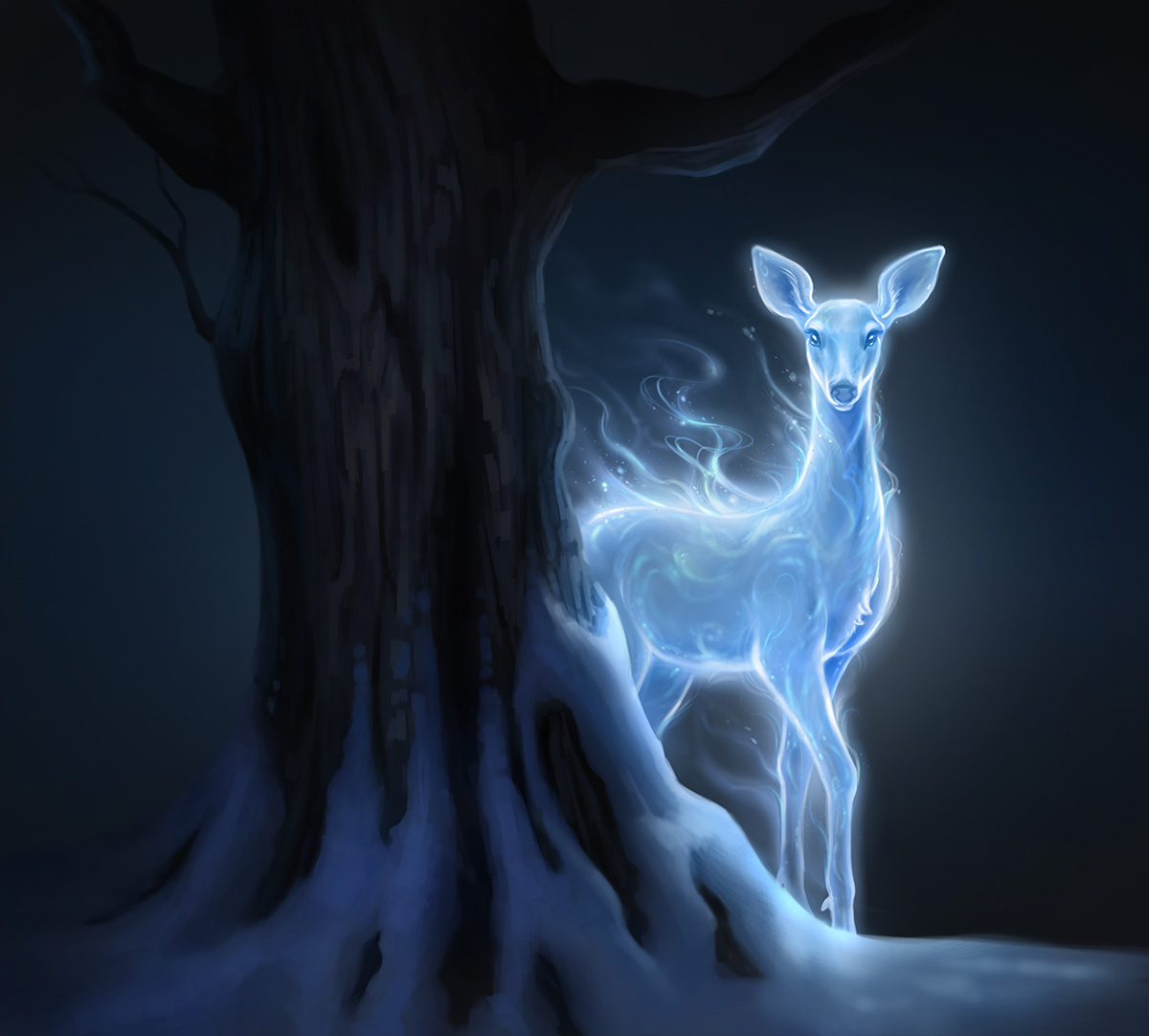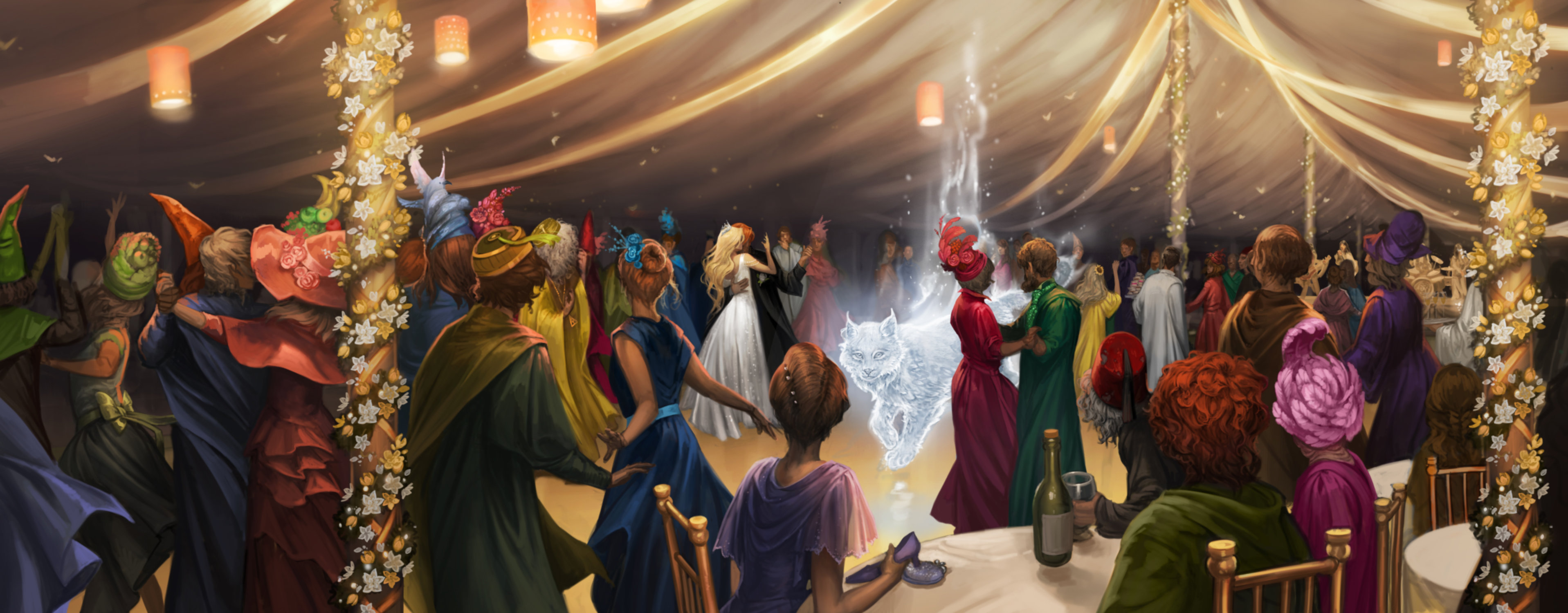www.pottermore.com/features/what-is-a-patronus
Who can cast this rather remarkable spell?
The Patronus is a form of advanced magic, which even the most qualified wizards can struggle with. Harry Potter is one of the youngest wizards to cast a corporeal Patronus, having been taught by Professor Lupin at the tender age of thirteen.
And, erm, what exactly is it?
As Professor Lupin tells Harry in Prisoner of Azkaban, the Patronus is ‘a kind of Anti-Dementor – a guardian which acts as a shield between you and the Dementor.’ It’s also ‘a kind of positive force, a projection of the very things that the Dementor feeds upon – hope, happiness, the desire to survive – but it cannot feel despair, as real humans can, so the Dementors can’t hurt it.’
The Patronus has two forms, non-corporeal and corporeal. A non-corporeal Patronus can appear as ‘a thin wisp of silver’ that hovers ‘like mist.’ Whereas a corporeal Patronus has a form that is clearly defined and is more than vapour or smoke.
The ability to cast a corporeal or non-corporeal Patronus is down to the skill of the witch or wizard. Each Patronus is unique to the witch or wizard who conjures it, and it’s possible, in some cases, for a Patronus to change.
Here are the witches and wizards who accomplished it, with some significant Patronus moments from across the stories.
Harry Potter – StagCITAZIONE
‘Harry flung himself out from behind the bush and pulled out his wand.
‘EXPECTO PATRONUM!’ he yelled.
And out of the end of his wand burst, not a shapeless cloud of mist, but a blinding, dazzling, silver animal. He screwed up his eyes, trying to see what it was. It looked like a horse.’
Harry Potter and the Prisoner of Azkaban
Harry’s Patronus takes the same shape as his father’s. He conjures it for the first time during a Dementor attack with Hermione and Sirius at the Great Lake, and at first glance it looks like a horse. Coincidentally, Harry’s future wife, Ginny Weasley’s Patronus is a horse.

James Potter – StagJames Potter’s Patronus is the same form as his Animagus.
Lily Potter – DoeThe female form of her husband’s Patronus.
We later learn that Severus Snape, in love with Lily for nearly his whole life, also had a doe for his Patronus.Albus Dumbledore – PhoenixCITAZIONE
‘Should I go and get someone?’ said Harry. ‘Madam Pomfrey?’
‘No,’ said Dumbledore swiftly. ‘Stay here.’
He raised his wand into the air and pointed it in the direction of Hagrid’s cabin. Harry saw something silvery dart out of it and streak away through the trees like a ghostly bird.’
Harry Potter and the Goblet of Fire
Dumbledore’s Patronus is a phoenix, which is revealed to us when he wants to summon Hagrid after Viktor Krum is Stunned. It can be no surprise that Dumbledore has an affinity with this particular creature, given that his own animal companion is an enigmatic and loyal phoenix, Fawkes.
Remus Lupin – WolfRemus Lupin often disguised his Patronus so as not to reveal the fact that he’s a werewolf.
Nymphadora Tonks – WolfCITAZIONE
‘Tonks’s Patronus has changed its form,’ he told him. ‘Snape said so, anyway. I didn’t know that could happen. Why would your Patronus change?’
Lupin took his time chewing his turkey and swallowing before saying slowly, ‘Sometimes … a great shock … an emotional upheaval …’
‘It looked big, and it had four legs,’ said Harry, struck by a sudden thought and lowering his voice. ‘Hey … it couldn’t be –?’
Harry Potter and the Half-Blood Prince
Yes, Harry, it could. Tonks’ Patronus changed into a wolf after she fell in love with Lupin, a sure sign of true love if ever there was one.
Minerva McGonagall – CatCITAZIONE
‘Come. We must alert the other Heads of House. You’d better put that Cloak back on.’
She marched towards the door, and as she did so she raised her wand. From the tip burst three silver cats with spectacle markings around their eyes. The Patronuses ran sleekly ahead, filling the spiral staircase with silvery lights, as Professor McGonagall, Harry and Luna hurried back down.’
Harry Potter and the Deathly Hallows
Well of course Professor McGonagall can cast a Patronus, and it being a spell of advanced magic, and she being Professor Minerva McGonagall, she can cast three at once. Here, McGonagall uses her Patronuses for communication – to alert the Heads of House that Hogwarts will soon be under attack from Voldemort, before the Battle of Hogwarts begins.
Severus Snape – DoeCITAZIONE
‘For him?’ shouted Snape. ‘Expecto patronum!’
From the tip of his wand burst the silver doe: she landed on the office floor, bounded once across the office and soared out of the window. Dumbledore watched her fly away, and as her silvery glow faded he turned back to Snape, and his eyes were full of tears.
‘After all this time?’
‘Always,’ said Snape.’
Harry Potter and the Deathly Hallows

Dolores Umbridge – CatFrom one of our very favourite professors to our very least, Dolores Umbridge’s Patronus is also a cat, just like the ones on those tasteless decorative plates she hangs from her walls.
Aberforth Dumbledore – GoatMeanwhile, Aberforth’s Patronus is a goat, which he summons outside the Hog's Head in an attempt to trick the Death Eaters that they’d seen a goat, rather than Harry's stag.
Kingsley Shacklebolt – LynxCITAZIONE
‘Graceful and gleaming, the lynx landed lightly in the middle of the astonished dancers. Heads turned, as those nearest it froze, absurdly, in mid-dance. Then the Patronus’s mouth opened wide and it spoke in the loud, deep, slow voice of Kingsley Shacklebolt.
‘The Ministry has fallen. Scrimgeour is dead. They are coming.’
Harry Potter and the Deathly Hallows
An example of a member of the Order of the Phoenix using their Patronus as a communication device, Shacklebolt’s lynx lands on the dancefloor at Bill and Fleur’s wedding.

Arthur Weasley – WeaselCITAZIONE
‘Harry drew his wand again and spun round to see a silver Patronus soar through the drawing-room window and land upon the floor in front of them, where it solidified into the weasel that spoke with the voice of Ron’s father.’
Harry Potter and the Deathly Hallows
How brilliant that Mr Weasley’s Patronus is a weasel.
Dumbledore’s ArmyIn Harry Potter and the Order of the Phoenix, Harry teaches his friends and fellow members of Dumbledore’s Army how to cast their Patronuses, with some having more luck than others:
Cho Chang – Swan
Seamus Finnigan – Fox
Hermione Granger – Otter
Luna Lovegood – Hare
Ernie Macmillan – Boar
Ginny Weasley – Horse
Ron Weasley – Jack Russell Terrier
They are later cast, with varying success and in support of Harry, during the Battle of Hogwarts:
CITAZIONE
‘He saw Ron’s silver terrier burst into the air, flicker feebly and expire; he saw Hermione’s otter twist in mid-air and fade, and his own wand trembled in his hand, and he almost welcomed the oncoming oblivion, the promise of nothing, of no feeling…
And then a silver hare, a boar and a fox soared past Harry, Ron and Hermione’s heads: the Dementors fell back before the creatures’ approach. Three more people had arrived out of the darkness to stand beside them, their wands outstretched, continuing to cast their Patronuses: Luna, Ernie and Seamus.’
Harry Potter and the Deathly Hallows
Lastly, how is a Patronus conjured?
With the incantation ‘EXPECTO PATRONUM.’ We don’t mean to shout, but really you have to say it like you mean it.



